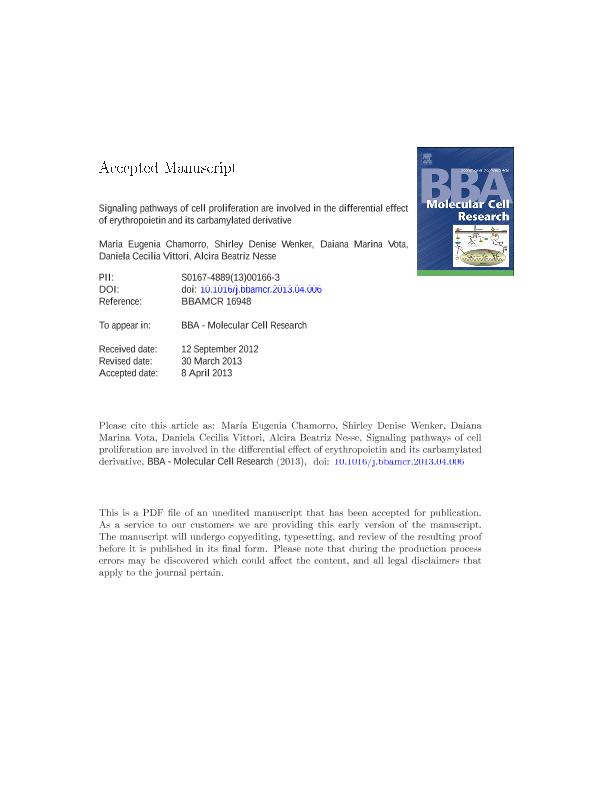Artículo
Signaling pathways of cell proliferation are involved in the differential effect of erythropoietin and its carbamylated derivative
Chamorro, María Eugenia ; Wenker, Shirley Denise
; Wenker, Shirley Denise ; Vota, Daiana Marina
; Vota, Daiana Marina ; Vittori, Daniela Cecilia
; Vittori, Daniela Cecilia ; Nesse, Alcira Beatriz
; Nesse, Alcira Beatriz
 ; Wenker, Shirley Denise
; Wenker, Shirley Denise ; Vota, Daiana Marina
; Vota, Daiana Marina ; Vittori, Daniela Cecilia
; Vittori, Daniela Cecilia ; Nesse, Alcira Beatriz
; Nesse, Alcira Beatriz
Fecha de publicación:
08/2013
Editorial:
Elsevier Science
Revista:
Biochimica Et Biophysica Acta-molecular Cell Research
ISSN:
0167-4889
Idioma:
Inglés
Tipo de recurso:
Artículo publicado
Clasificación temática:
Resumen
It is now recognized that in addition to its activity upon erythroid progenitor cells, erythropoietin (Epo) is capable of stimulating survival of different non-erythroid cells. Since stimulation of erythropoiesis is unwanted for neuroprotection, Epo-like compounds with a more selective action are under investigation. Although the carbamylated derivative of erythropoietin (cEpo) has demonstrated non-hematopoietic tissue protection without erythropoietic effect, little is known about differential mechanisms between Epo and cEpo. Therefore, we investigated signaling pathways which play a key role in Epo-induced proliferation. Here we show that cEpo blocked FOXO3a phosphorylation, allowing expression of downstream target p27kip1 in UT-7 and TF-1 cells capable of erythroid differentiation. This is consistent with the involvement of cEpo in slowing down G1-to-S-phase progression compared with the effect of Epo upon cell cycle. In contrast, similar antiapoptotic actions of cEpo and Epo were observed in neuronal SH-SY5Y cells. Inhibition and competition assays suggest that Epo may act through both, the homodimeric (EpoR/EpoR) and the heterodimeric (EpoR/βcR) receptors in neuronal SH-SY5Y cells and probably in the TF-1 cell type as well. Results also indicate that cEpo needs both the EpoR and βcR subunits to prevent apoptosis of neuronal cells. Based on evidence suggesting that cell proliferation pathways were involved in the differential effect of Epo and cEpo, we went forward to studying downstream signals. Here we provide the first evidence that unlike Epo, cEpo failed to induce FOXO3a inactivation and subsequent p27kip1 downregulation, which is clearly shown in the incapacity of cEpo to induce erythroid cell growth.
Palabras clave:
Erythropoietin
,
Carbamylated Erythropoietin
,
Foxo 3a
Archivos asociados
Licencia
Identificadores
Colecciones
Articulos(IQUIBICEN)
Articulos de INSTITUTO DE QUIMICA BIOLOGICA DE LA FACULTAD DE CS. EXACTAS Y NATURALES
Articulos de INSTITUTO DE QUIMICA BIOLOGICA DE LA FACULTAD DE CS. EXACTAS Y NATURALES
Articulos(OCA CIUDAD UNIVERSITARIA)
Articulos de OFICINA DE COORDINACION ADMINISTRATIVA CIUDAD UNIVERSITARIA
Articulos de OFICINA DE COORDINACION ADMINISTRATIVA CIUDAD UNIVERSITARIA
Citación
Chamorro, María Eugenia; Wenker, Shirley Denise; Vota, Daiana Marina; Vittori, Daniela Cecilia; Nesse, Alcira Beatriz; Signaling pathways of cell proliferation are involved in the differential effect of erythropoietin and its carbamylated derivative; Elsevier Science; Biochimica Et Biophysica Acta-molecular Cell Research; 1833; 8; 8-2013; 1960-1968
Compartir
Altmétricas



